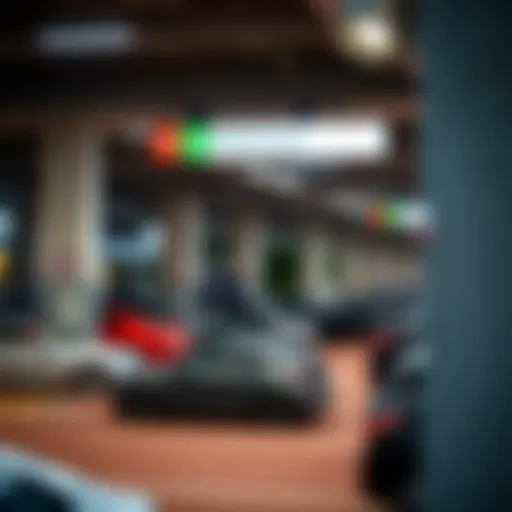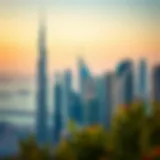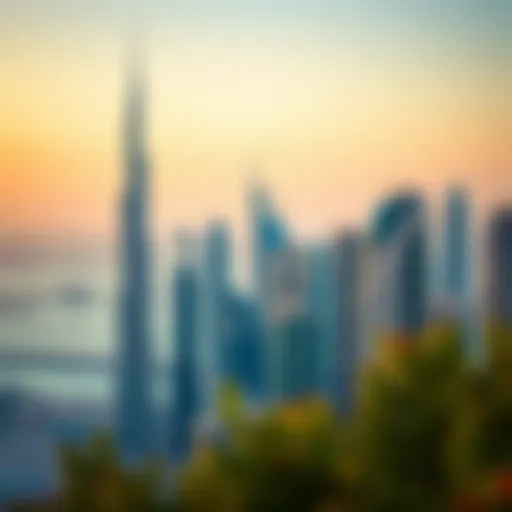Discovering the Art of Illusions at Dubai Museum
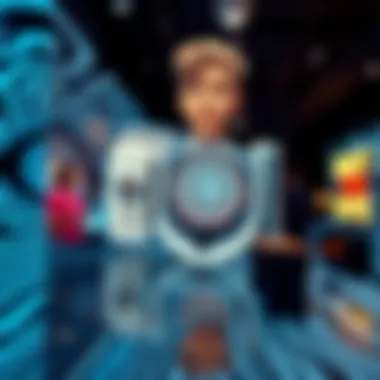

Intro
The Dubai Illusion Museum offers visitors a unique lens into the world of visual deception. It blends artistry with perceptual tricks, crafting an experience that both entertains and educates. At the heart of this venture lies a determination to push the limits of traditional art and create an engaging space. This museum isn’t merely about observing art; it invites exploration and interaction, effectively blurring the lines between reality and illusion.
The significance of such a venue in Dubai cannot be overstated. As a thriving hub known for its opulence and innovative attractions, the museum enhances the city’s cultural tapestry. It stands as a testament to the creative spirit of the region, attracting tourists, art enthusiasts, and curious locals alike. Visitors find themselves immersed in a variety of exhibits that provoke thought and elicit wonder, often eliciting reactions of surprise and enjoyment.
In this article, we will take a closer look at what the Dubai Illusion Museum offers. From the inception and artistic vision that brought this concept to life, to the ways in which it fits into the broader context of Dubai's evolving cultural landscape, every aspect will be explored. Additionally, by examining the techniques used within the museum, we will unravel the psychology behind visual deceptions, providing insights into how illusions operate on our minds. Finally, we’ll touch upon the significance of such artistic spaces in terms of real estate and tourism, clarifying how they impact investment opportunities in Dubai.
Prologue to the Dubai Illusion Museum
The Dubai Illusion Museum brings a blend of creativity and cognitive exploration to the heart of the thriving metropolis. In a city renowned for its architectural marvels and extravagant entertainment options, this museum occupies a unique niche by delving into the realm of visual deception and artistry. As visitors step through its doors, they embark on a journey that not only entertains but also educates, challenging their perceptions and igniting their curiosity.
One might wonder, what drives the fascination with illusion? The museum’s concept is rooted in the idea that art can transcend mere decoration, serving as a platform for deeper engagement with the mind. By examining how our brains interpret visual stimuli, each installation within the museum promotes an understanding of human perception that extends beyond the surface. This importance cannot be overstated, especially in today’s world where visual literacy is becoming increasingly vital.
Concept and Vision
The vision for the Dubai Illusion Museum is bold yet elegantly simple: to challenge how people see and appreciate art. Set against a backdrop of innovation, the museum showcases art that ticks the boxes for being both captivating and thought-provoking. The creative team behind this project not only envisioned a gallery of stunning visuals but also an interactive space where audience participation is woven seamlessly into the fabric of the exhibit. The mission is clear – to dissolve the barriers between observer and creator, allowing for a dialogue that enriches the overall experience.
Imagine a place where the laws of physics seem to bend, where a flat image can invoke a three-dimensional response, or a twisted perspective can evoke feelings of disorientation. This approach aims not only to show the intricacies of art but also to highlight how perception shapes reality.
Location and Significance
Strategically nestled within Dubai, the museum's location plays a pivotal role in attracting a diverse array of visitors. The city itself is a bustling convergence point for culture, commerce, and tourism. The Illusion Museum stands as a testament to Dubai’s commitment to creativity and innovation, offering locals and tourists a fresh perspective amid traditional tourist attractions.
Welcoming both families and art aficionados alike, the museum's accessibility promotes inclusivity, inviting individuals from various backgrounds to engage with artistry in an experiential manner. Its significance extends beyond the museum walls; it sparks discussions around art, perception, and psychology, thereby enriching the ongoing cultural narrative of Dubai.
"Art is not what you see, but what you make others see." – Edgar Degas
In summary, the Dubai Illusion Museum offers much more than mere entertainment; it serves as a landmark for understanding the intricate dance between art and human perception. As we delve deeper into its architectural nuances, exhibitions, and cultural relevance, this exploration promises to reveal not just the museum’s physical offerings but also its profound implications for art, tourism, and real estate in Dubai.
Design and Architecture
The design and architecture of the Dubai Illusion Museum provide a crucial lens through which to understand its mission and artistic offerings. This section highlights how the interplay between form and function in the museum not only enhances its visual appeal but also serves to deepen the visitor's engagement with the art of deception. When one wanders the halls of the museum, it becomes clear that every aspect of its design has been meticulously crafted to influence how visitors perceive and interact with the illusions on display.
Structural Elements
The structural elements of the museum are nothing short of astounding. Constructed with cutting-edge materials and techniques, the building stands as a testament to modern architectural prowess. The external facade boasts an intricate pattern that draws the eye and creates a sense of curiosity before one even steps inside. The exterior’s reflective surfaces play with light, integrating seamlessly with Dubai’s sun-drenched environment to create an ever-changing mosaic of reflections.
Inside, the museum embraces an open layout that invites exploration. Vast, airy spaces give visitors room to roam freely, while strategically placed walls serve to frame the illusions, guiding observers' experiences. This design choice fosters an atmosphere that encourages visitors to engage fully with each installation. In a way, the museum itself becomes an illusion, challenging visitors to look closer and question what they see.
"The journey through the museum mirrors a dance with perception. Each corner turned brings a new surprise, just like a magician's trick unfolding."
Moreover, sustainability elements are woven into the structural framework. Rainwater harvesting systems and energy-efficient lighting solutions reflect a growing commitment to environmentally conscious design. Investors and stakeholders might appreciate how such initiatives can not only save costs in the long run but also bolster the museum's reputation as a forward-thinking establishment.
Interior Layout
Transitioning to the interior layout, the design is pivotal in enhancing the overall visitor experience. The layout comprises a series of interconnected galleries, each curated to highlight various aspects of visual deception. The thoughtfully arranged spaces allow for a logical flow, enabling visitors to progress from one illusion to the next without feeling rushed or overwhelmed.
Each room is adorned with sensory details that augment the artistic experience. The careful selection of colors and lighting is tailored not just for aesthetics. They play a psychological role, helping visitors to feel disoriented or in awe as they navigate through illusions. For instance, some areas might use dim lighting to enhance mystery, while others are bright and expansive, creating a stark contrast that adds to the overall drama of the experience.
Furthermore, the incorporation of interactive spaces where visitors can step into a painting or manipulate an illusion fosters a personal connection with the artwork. This aspect has valuable implications. From an investment standpoint, such interactivity can significantly increase visitor engagement and duration of stay, naturally translating to higher revenue from ticket sales and on-site purchases. This strategic foresight positions the museum as a prime attraction within Dubai’s evolving cultural tapestry.
In essence, the design and architecture of the Dubai Illusion Museum work hand-in-hand to create a compelling narrative that celebrates visual deception. As a focal point for art and investment, it not only aims to please the eye but also stimulates the mind in unexpected ways.
Exhibitions and Installations
The Exhibitions and Installations section is at the heart of the Dubai Illusion Museum, showcasing the very essence of what makes this destination a haven for art lovers and curious minds alike. Here, the importance of experiencing visual deception becomes crystal clear. Each exhibition not only aims to dazzle the eyes but also to challenge preconceived notions about reality, leaving visitors pondering what they just witnessed.
Types of Illusions
In this museum, illusions come in all shapes and sizes. From 3D anamorphic art which appears to leap off the walls, to mirror mazes that create infinite reflections, each type draws visitors into a delightful conundrum. The significance of these illusions cannot be understated – they encourage guests to think critically about how they perceive the world.
- Optical Illusions: These pieces play tricks on the mind, making simple images appear dynamic and alive. They remind us of how easily our brain can be fooled.
- Perspective Art: This involves manipulating the viewer's perception through clever angles and drawing techniques. It’s fascinating how a painting can look completely different depending on your position.
- Augmented Reality Installations: By integrating technology, these installations offer a glimpse into the fusion of art and innovation, inviting visitors to explore in ways they never expected.
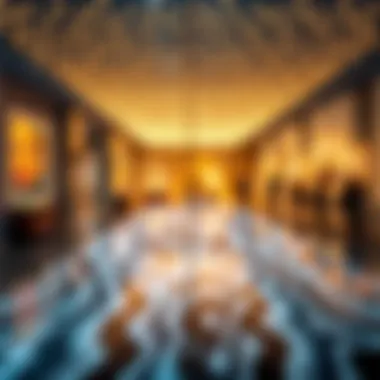

"Art is not what you see, but what you make others see." – Edgar Degas
Interactive Experiences
Diving deeper into the museum's offerings, the interactive experiences stand out as a significant element that enhances visitor engagement. It’s one thing to gaze upon artistic wonders; it’s entirely another to touch, play, and interact. Many installations invite participation, urging guests to engage actively rather than passively consuming art. Visitors can pose with life-sized illusions or create their very own illusions through interactive screens, which adds depth to their visit.
- Photo Opportunities: Visitors are encouraged to take pictures that become part of the art. Poses that appear to defy gravity or humorous contexts are not just great for social media; they weave each visitor into the narrative of the installations.
- Workshops and Demonstrations: Regularly scheduled workshops provide hands-on experiences, letting the curious create their illusions. This not only educates but fosters a sense of community among guests.
Featured Artists
The Featured Artists segment is a celebration of creativity and skill. Renowned artists from various backgrounds contribute their unique touch, ensuring every visit is different. The personalities behind the art are often as intriguing as the illusions themselves. For instance, newcomers might find their way into the limelight alongside established figures, providing a platform for fresh ideas in visual deception.
- Diverse Backgrounds: Artists hail from Emirati roots to international fame, each bringing their cultural touch to the exhibits. This blend offers a rich tapestry of art that resonates with the multicultural landscape of Dubai.
- Collaborations with Local Talent: By promoting local artists, the museum enhances community ties, transforms journeys into dialogues, and showcases original works that resonate with many.
As visitors explore this segment, they encounter more than just visual tricks; they see the thought process, history, and cultural narratives etched into each artwork. This elevates the museum from a mere tourist attraction to a hub for educational experiences and artistic growth.
The interplay of these exhibitions and installations ultimately shapes the museum into a crucial cultural landmark in Dubai, reflecting not just art but also a societal appreciation for perception and reality.
Psychology of Perception
In the context of the Dubai Illusion Museum, the psychology of perception plays a pivotal role in shaping not just the visitor's experience but also the underlying artistic techniques employed throughout the exhibits. This fascinating field delves into how our brains interpret visual stimuli, and in the case of illusions, it reveals the often surprising disconnect between what we see and what is real.
Understanding perception can significantly enhance the appreciation of the artworks on display. Observe how an artist like Patrick Hughes uses perspective to create a three-dimensional appearance on a two-dimensional canvas. It’s much more than just colors and shapes—every angle and line is meticulously considered to trick the eye while inviting contemplation about our cognitive processes. This entry point into psychology goes beyond the aesthetic; it engages visitors in a dialogue about how their minds create reality.
Moreover, this information is not just educational; it fuels engagement. People love to share their realizations and experiences with friends and family, which inherently encourages community dialogue around art and perception. This communal aspect is vital as it fosters a deeper understanding of the ways art can illuminate psychological concepts.
Understanding Optical Illusions
Optical illusions are at the heart of what the Dubai Illusion Museum stands for. They serve as gateways to understanding the complexities and sometimes the fallacies of our visual perception. For example, the famous "Rubin's Vase" can be seen either as a goblet or two faces depending on the viewer's focus. Why does this happen?
The answer lies in how visual processing works. Our brains are wired to fill in gaps, to seek patterns, and at times, to deduce conclusions drawn from insufficient information. In environments like the illusion museum, these concepts come to life in a curated form, allowing visitors to physically interact with illusions that can challenge their preconceptions.
Key Features of Optical Illusions Include:
- Dual Interpretations: Many illusions provide multiple perspectives, encouraging viewers to switch their focus and challenge their brain's expectations.
- Color and Contrast: Certain visuals can manipulate color perception, where two colors can appear entirely different based on context.
- Movement Illusions: Some installations can trick the eye into seeing motion in a still image, further exemplifying the nuanced nature of perception.
By aspiring to engage the audience through these multi-layered experiences, the museum enhances the fundamental understanding of how we process visual information. It is not just a spectacle but an elaboration of cognitive theory embodied in artistic form.
Cognitive Impact
The effects of experiencing optical illusions stretch far beyond mere amusement. They have profound implications for cognitive function and behavior. Engaging with these illusions can sharpen our minds and improve critical thinking skills. Research often points to how observing optical phenomena can create an awareness of cognitive biases and perception errors.
Consider the methodical approach of artists like Escher, whose work epitomizes complex structures that defy logical spatial reasoning. Visiting such exhibits prompts reflection, leading individuals to question their previous conclusions and understanding of the world.
"Art enables us to find ourselves and lose ourselves at the same time." - Thomas Merton
Noteworthy Impacts of Cognitive Engagement:
- Heightened Awareness: Regular exposure to optical illusions can help people become aware of their cognitive shortcuts, leading to better decision-making.
- Enhanced Creativity: Participants may find inspiration by engaging with visual puzzles, fostering creativity in their own art or problem-solving endeavors.
- Social Interaction: Discussing interpretations of illusions encourages collaborative thought processes, making it a social experience.
In this way, the Dubai Illusion Museum not only entertains but also stimulates intellectual discourse and cognitive development, making it a remarkable space for both individuals and communities.
Cultural Significance in Dubai
The Dubai Illusion Museum stands as a beacon of cultural engagement, illustrating how art can transcend mere aesthetic appreciation to foster meaningful conversations. Within a city characterized by its fast-paced growth and eclectic blend of cultures, this museum emerges not just as an entertainment hub but as a platform for dialogue about perception, reality, and identity.
Art as a Medium for Dialogue
Art is a powerful tool for dialogue, enabling discourse across barriers of language and tradition. At the Dubai Illusion Museum, artworks that play with the viewer’s perception initiate discussions about how we interpret the world around us. The installations encourage visitors to question their senses, offering a personal reflection on how art embodies the complexities of human experience.
Here, abstraction meets reality. Visitors can engage with pieces that challenge normative perspectives, fostering a common ground between vastly different cultural backgrounds. The act of viewing illusions becomes a shared journey, stimulating not just individual introspection but collective engagement. Consider the following aspects of this dialogue:
- Cultural Exchange: The museum attracts a diverse audience, from local Emiratis to international tourists, each bringing unique insights.
- Fostering Creativity: Through interactive exhibits, visitors are inspired to think creatively, contributing to an ongoing conversation about innovation in the arts.
- Social Connectivity: The museum hosts workshops and events that connect artists and spectators, promoting a sense of community among attendees.
In these ways, art becomes a medium through which boundaries blur, and dialogue flows seamlessly between cultures and perspectives.
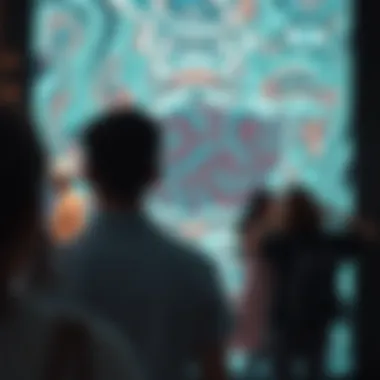

Tourism and Local Impact
The implications of the Dubai Illusion Museum extend beyond the walls of its engaging exhibits; it plays a significant role in shaping local tourism dynamics and economic growth. As the city seeks to position itself as a global cultural destination, the museum complements Dubai's existing attractions while bringing a unique offering to the table.
Highlighting the relationship between tourism and local economies, consider how the Illusion Museum is making waves:
- Increased Foot Traffic: As a new attraction, the museum draws thousands of curious visitors yearly, boosting nearby businesses such as restaurants, cafes, and retail stores.
- Employment Generation: The establishment of the museum has created various job opportunities, supporting local talent in art, hospitality, and management.
- Cultural Diversification: By presenting a non-traditional form of art, the museum enriches the cultural tapestry of Dubai, appealing to a younger demographic looking for more than conventional tourist experiences.
The significance of the museum thereby ripples through the local economy, propelling Dubai forward as a vibrant, culturally-rich metropolis.
"Art speaks where words are unable to explain"—this sentiment underlines the ethos of the Dubai Illusion Museum, making it a relevant piece in the puzzle of Dubai’s cultural landscape.
As both a facilitator of dialogue and a catalyst for tourism growth, the museum embodies the spirit of innovation and creativity that Dubai has come to symbolize.
Real Estate Nexus
The connection between the Dubai Illusion Museum and the real estate market is more than just surface level. This nexus forms a critical aspect of understanding how cultural attractions influence investment decisions, property values, and neighborhood dynamics. As more visitors flock to the museum, drawn by its innovative displays and immersive experiences, the surrounding real estate naturally sees increased activity.
Benefits of the Real Estate Nexus
The impact of such an artistic venue transcends mere foot traffic. Potential investors and homeowners typically seek out areas with rich cultural offerings. Here’s how the museum contributes:
- Increased Footfall: More visitors lead to thriving local businesses, which in turn boosts the attractiveness of nearby real estate. Properties that lie within close proximity to cultural institutions often see enhanced appeal, driving up demand and prices.
- Enhanced Community Vibe: Cultural landmarks foster a sense of community. The museum’s interactive and educational aspects can make the neighborhood feel vibrant and engaging.
- Rental Potential: With tourism on the rise, short-term rental opportunities flourish. Investors can capitalize on this trend, particularly in a city like Dubai, where travelers seek unique experiences.
"Cultural landmarks such as the Dubai Illusion Museum amplify local real estate dynamics, weaving culture into the fabric of communities."
Attraction for Investors
The allure of the Dubai Illusion Museum acts as a beacon for potential investors looking at opportunities in the area. The investment landscape in Dubai is heavily influenced by tourism and cultural offerings. The presence of such an innovative museum signals a growth potential for real estate approximately nearby.
Investors find comfort in knowing that properties near popular attractions tend to retain their value—sometimes even appreciate more than others in less dynamic areas.
Key Factors for Investors
- Market Stability: Cultural institutions often contribute to a consistent influx of visitors. This stability suggests a reliable demand for housing and rentals.
- Brand Association: Properties linked with strong cultural identities can command higher prices, making them attractive investments.
- Future Development: The interest and investment in cultural attractions often lead to further development and infrastructure improvements in the area, leading to overall appreciation in property values.
Neighborhood Dynamics
Neighborhood dynamics around the Dubai Illusion Museum illustrate how art and community can intertwine to create a vibrant social fabric. The museum is not only a place for visitors to engage with art; it's also a catalyst for change within its locality.
Transformative Changes in the Neighborhood
- Commercial Growth: The spillover effects of a cultural landmark often lead local businesses to flourish, creating a diverse marketplace for both residents and tourists. Cafés, restaurants, and boutiques thrive in proximity, enhancing the everyday experience for those who live and visit.
- Civic Engagement: Art, as a form of engagement, strengthens community bonds. Residents might rally around events hosted by the museum, bringing about a collective identity and pride.
- Urban Projects: The museum’s success might incite local governments and developers to consider new urban projects, like parks and recreational spaces, which further uplift area appeal.
In summary, the real estate nexus associated with the Dubai Illusion Museum is a multifaceted phenomenon that blends investment opportunities with community life, shaping the dynamics of property value and neighborhood engagement. Investors looking for a promising trajectory in the Dubai market should undoubtedly consider the implications of cultural institutions like this museum.
Visitor Experience
The visitor experience at the Dubai Illusion Museum is pivotal to understanding its allure and modern appeal. This experience transcends mere observation, engaging guests in a dynamic interplay between art and perception. Individuals flock to the museum not just for a day out, but for a chance to interact with art in ways that bend reality. This, in turn, creates a fusion of entertainment and education, making the museum a noteworthy destination.
Fundamentally, the visitor experience emphasizes interactive participation over passive observation. From stepping into a room that seems to shrink as you walk deeper in, to engaging with optical illusions firsthand, each moment is designed to evoke curiosity and wonder. Such experiences offer numerous benefits, including enhancing cognitive skills while challenging one’s perceptions; who knew a simple trip could act as a playful workout for the brain?
Consideration should also be given to the very elements that enrich this experience:
- Immersive Installations: Each exhibit invites guests to become part of the artwork, crafting memories that stand out in contrast to traditional gallery visits.
- Inclusiveness: With interactive settings for all ages, children and adults alike find delight in the same space. This sense of community makes experiences shared with family and friends all the more meaningful.
- Cultural Engagement: The museum’s theme ties back to broader cultural narratives, as laughter and surprise become a bridge for conversation among visitors from varied backgrounds.
Ultimately, the museum is not merely a collection of displays, but a meticulously crafted environment that transforms passive spectators into active participants. Visitors leave with more than just photos; they carry with them a sense of awe and a newfound understanding of visual arts that play tricks on the mind.
Guided Tours
Guided tours at the Dubai Illusion Museum elevate the visitor experience significantly. While guests can wander through at their own pace, the guided sessions offer deeper insights into each illusion. These tours are usually led by knowledgeable staff, who share tidbits about the artists and the psychological concepts behind the illusions.
A well-informed guide can illuminate the subtleties and intricacies of installations, making the experience richer. The guide may explain why certain pieces manipulate light or perspective, allowing participants to grasp the art on an intellectual level. Additionally, this interactive form of narrative can trigger thought-provoking discussions:
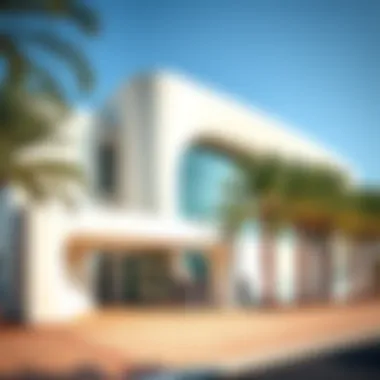

- Artistic Intent: Each piece serves a unique purpose within the museum, reflecting not only the artist’s vision but also the intent behind every designed illusion.
- Historical Context: For example, some illusions may weave in historical artistry methods that have shaped contemporary techniques. This overview enriches the overall understanding of art evolution.
Moreover, guided tours often feature time slots that accommodate a limited group, fostering intimacy and an air of exclusivity. Such close-knit gatherings create space for personalized questions and explorations that wouldn’t be feasible in larger crowds. They allow visitors to engage with the material in a manner that resonates deeply.
Visitor Amenities
Amenities available at the Dubai Illusion Museum significantly enhance the overall visitor experience. They are designed to cater to various needs, ensuring a comfortable and enjoyable atmosphere. Below are some of the key amenities that cater to guests:
- Cafeteria and Refreshments: After a day filled with visual wonders, a cozy café awaits to provide refreshments, allowing visitors to relax and discuss their experiences over a cup of coffee or a light snack.
- Photography Opportunities: Many specific areas within the museum are designed with the intent to capture memorable photos, with props and backdrops that amplify the illusion experience, making social media sharing irresistible.
- Souvenir Shops: Visitors can take home a piece of the museum experience through a selection of unique merchandise. This could range from books about the illusions to engaging puzzles that challenge the mind.
- Accessibility Features: The museum prioritizes inclusivity with facilities that ensure everyone can enjoy the exhibits, including ramps, elevators, and sensory-friendly spaces for those who require additional accommodations.
The thoughtful integration of these amenities not only supports visitor satisfaction but also reinforces the museum's commitment to a holistic experience where comfort and joy are at the forefront.
In closing, the visitor experience is more than just a ticket and a look around. It’s an adventure into the surprising elements of art, seamlessly blending imagination and intellect. The guided tours and amenities work hand in hand to provide a comprehensive indulgence, leaving guests feeling enriched and eager to return.
Challenges and Criticisms
Exploring the nuances of the Dubai Illusion Museum unveils various challenges and criticisms it faces, significant in shaping the cultural dialogue surrounding this unique establishment. As a beacon of artistry and perception, it does attract its fair share of scrutiny. Like any artificial creation shimmering in Dubai’s vibrant landscape, it cannot escape the critical lens of observers dissecting its impact on both artistic expression and sustainability.
Artistic Integrity
Artistic integrity acts as the backbone of the exhibits housed within the museum. Critics often argue that the emphasis on entertainment can occasionally overshadow the deeper artistic messages intended by the creators. The subtlety with which illusions convey meaning sometimes gets lost in the flood of visual spectacle.
For example, installations might attract crowds primarily looking for engaging photos rather than reflecting on the techniques employed or the themes explored. This phenomenon raises an eyebrow among critics who value art’s potential for meaningful dialogue. While commercial success is essential, there is a fine line where the authenticity of artistic expression could waver.
"Art should provoke thought; merely tricking the eye doesn't compute for everyone."
Visitors, therefore, have a dual challenge – to enjoy the visual playfulness while introspecting on the underlying messages, challenging themselves to delve deeper rather than merely skimming the surface of perception and artistry.
Sustainability in Art
Sustainability is another critical dialogue point when addressing the museum’s impact. While the Dubai Illusion Museum contributes to the local economy through tourism, it also raises questions about environmental responsibility.
In an age where eco-friendliness is paramount, the creativity shown within exhibits needs to align with sustainable practices. Aspects such as the choice of materials in art pieces, energy consumption for installations, and waste management during exhibitions are under scrutiny. For instance, if significant amounts of plastic are used within exhibits, it could conflict with a broader movement towards sustainability and environmental awareness.
Making art that resonates while also being mindful of environmental footprints is a tightrope walk, but it is an essential consideration in today’s world.
The path ahead may well involve redefining how the museum can marry innovation with sustainability.
Future Prospects
The future of the Dubai Illusion Museum holds promise not only for artistic appreciation but also for its expanding role in Dubai's socio-economic fabric. This section outlines how the museum might evolve, touching on anticipated expansions and its impact on the city's cultural landscape.
Expansion Plans
In light of its growing popularity, the museum is gearing up for a series of exciting expansion plans. These developments aim to enhance visitor engagement and broaden the range of experiences offered. Imagine stepping into an area dedicated solely to immersive virtual reality experiences, where visitors can interact with illusions in a more personal manner. Such technology could lead to specialized exhibitions that change frequently, keeping the attraction fresh and encouraging repeat visits.
Furthermore, plans may include collaborating with local and international artists to curate temporary exhibitions that highlight various perspectives on visual deception. This could lead to community art projects, encouraging local talents to showcase their work alongside world-renowned artists. The museum may find itself as a platform fostering creativity, bridging gaps between cultures through art.
Role in Dubai’s Changing Landscape
As Dubai continues to evolve, so does the role of the Illusion Museum within the city's landscape. With a city known for its ever-innovating spirit and ambition, the museum stands as a testament to the blend of art and technology. In an environment where traditional markets meet modern aesthetics, the museum offers a unique vantage point for investors and tourists alike.
Its existence encourages a shift in perceptions about art in Dubai, positioning the city as a hub for creative tourism. This innovative approach not only enhances the cultural portfolio of Dubai but also positively impacts real estate, drawing in those keen on investing in properties that promise foot traffic from visitors seeking experiential attractions.
Moreover, the museum aligns with the UAE’s vision for developing cultural tourism as an economic pillar. It provides an educational experience that complements the city's more traditional attractions, creating a balanced offering for visitors. Thus, as the museum continues to adapt to changes and foster new initiatives, it will remain a crucial part in not just the art scene, but in the broader context of Dubai's growth narrative.
"The real magic lies in how the Dubai Illusion Museum can turn perception into reality, impacting both visitors and the city's culture deeply."
The End
The conclusion of this exploration into the Dubai Illusion Museum encapsulates the essence of what the museum signifies in the realm of art, perception, and its broader implications for Dubai's urban landscape. In this section, we aim to distill the experience of visiting the museum into key takeaways while also reflecting on its impact on various sectors such as real estate and tourism.
Summarizing the Experience
As visitors step into the Dubai Illusion Museum, they engage in a multifaceted experience that transcends mere visual enjoyment. The interplay of light, shadows, and intricate designs crafts a journey through the realms of illusion and reality. Each exhibit is a gateway to understanding how our minds can be tricked, an engaging opportunity that teaches without preaching. This museum effectively amalgamates artistry and science, illuminating not just illusions but the very nature of perception itself.
- Interactive Displays: The museum isn't just about looking; it’s about doing. Many exhibits encourage interaction, ensuring that visitors learn by experiencing.
- Diverse Themes: From classic illusions to modern installations, the thematic variety caters to a wide range of interests, ensuring everyone finds something captivating.
- Informed Staff: Knowledgeable guides enhance the experience, offering insights that make the visit even more enriching.
It's not merely entertainment—it's an educational experience that dares guests to question their perceptions.
Cultural Contributions to Real Estate
The cultural significance of the Dubai Illusion Museum extends far beyond its walls. By establishing itself as a landmark within the vibrant tapestry of Dubai, it creates a ripple effect in the real estate sector. It draws not only tourists but also potential investors and residents who are intrigued by cultural developments.
- Boosting Local Real Estate: The increased foot traffic and attention on the museum contribute to rising property values in the surrounding neighborhoods. As people flock to this new cultural icon, businesses sprout up to serve them, further increasing the desirability of the area.
- Attracting Investment: Investors are increasingly drawn to properties near culturally significant landmarks. The museum’s presence signals growth and development potential, making it an attractive option for those looking to invest in Dubai’s thriving market.
- Community Engagement: Local art and design initiatives often partner with the museum, fostering a community atmosphere that encourages investment and personal connection to the area.
All in all, the Dubai Illusion Museum stands as a testament to how culture can not only enrich lives but also drive economic factors such as real estate investment, thus shaping the city’s future and reifying its status as a cultural hub. In embracing the whimsical and the thought-provoking, the museum tunes into the pulse of Dubai, reflecting its innovative spirit while cementing its place as an essential destination.





